Save money and ensure that you have the highest quality ingredients by making your own vanilla extract. It’s super easy to make and makes a great gift.
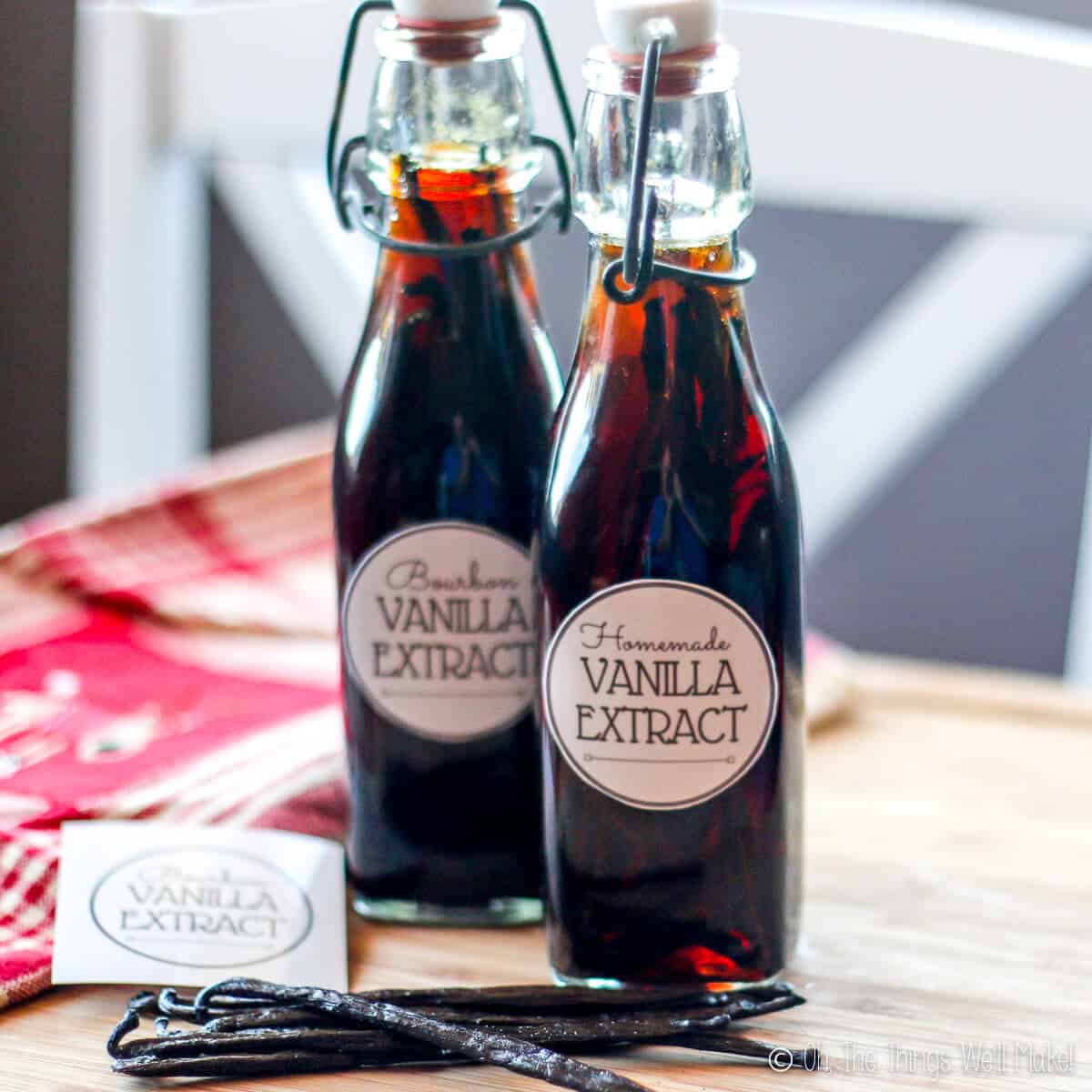
Anybody that has been baking American recipes for a while knows that many recipes call for vanilla extract! It’s not just for vanilla ice cream. Vanilla extract shows up in almost every baking recipe ever written.
Here in Spain, though, vanilla isn’t as commonly used. Most stores don’t sell pure vanilla extract. Instead, they normally have vanilla beans or artificial vanilla flavoring.
While I do love vanilla beans, they aren’t always the most convenient thing to use for most recipes. As for the vanilla flavoring? Those of you that have been following me for a while probably know that I’m not a big fan of chemically produced artificial products.
Why make it?
I choose to make my own vanilla extract because I couldn’t find it easily here. Even if you can easily find vanilla extract where you live, though, it could make sense to make your own.
Pure vanilla extract can be pricey, so, if you can get a good deal on vanilla beans, you can save yourself money.
It’s not just about the money, though, it’s about the control. You can choose which ingredients you want to use to get the flavor you prefer. You can also ensure that you are using a true vanilla flavoring that comes from the vanilla bean.
Not all vanilla flavorings are what they seem…
Where does vanilla flavoring come from?
Did you know that even “naturally” flavoured vanilla products might not actually be using vanilla?
That statement sounds crazy, but it’s all too true!
Natural vanilla flavor can actually come from beavers in the form of castoreum. Castoreum is a secretion from the castor sacs of beavers. Because of the location of the castor sacs, at the base of the beaver’s tail, castoreum may also contain urine and anal gland secretions! Yum!
So, if you are a vegetarian or vegan, and are eating something with “natural vanilla flavoring”, you may unwittingly be consuming an animal product, and a not-so-appealing one at that!
To avoid all that grossness, the first years I was living here, I brought vanilla extract in bulk back to Spain with me each time I went back to visit the US, but I finally decided it made more sense to make it myself.
Ingredients
Homemade vanilla extract only uses 2 ingredients, vanilla beans and alcohol. To be considered a true extract, the alcohol should be at least 35% strength (70 proof).
Vanilla beans
If you choose vanilla beans from the supermarket that are sold individually, you may not save money by making your own extract. On the other hand, if you buy vanilla beans online in bulk, you can save a lot by making your own! To save even more, choose “extract grade” vanilla beans that tend to be smaller and drier but also much less expensive.
Vanilla beans can vary in flavor depending on where they are from.
- Bourbon vanilla beans, or Madagascar vanilla beans, come from the Planifolia orchid. They provide a classic tasting vanilla flavor.
- Tahitian vanilla beans, from the Tahitensis species (a cross between Vanilla planifolia and Vanilla odorata), have a more exotic, tropical flavor that is a bit unique.
- Mexican vanilla beans also come from the vanilla planifolia plant and are very similar to the Madagascar vanilla. They tend to be slightly thinner and subtle in flavor.
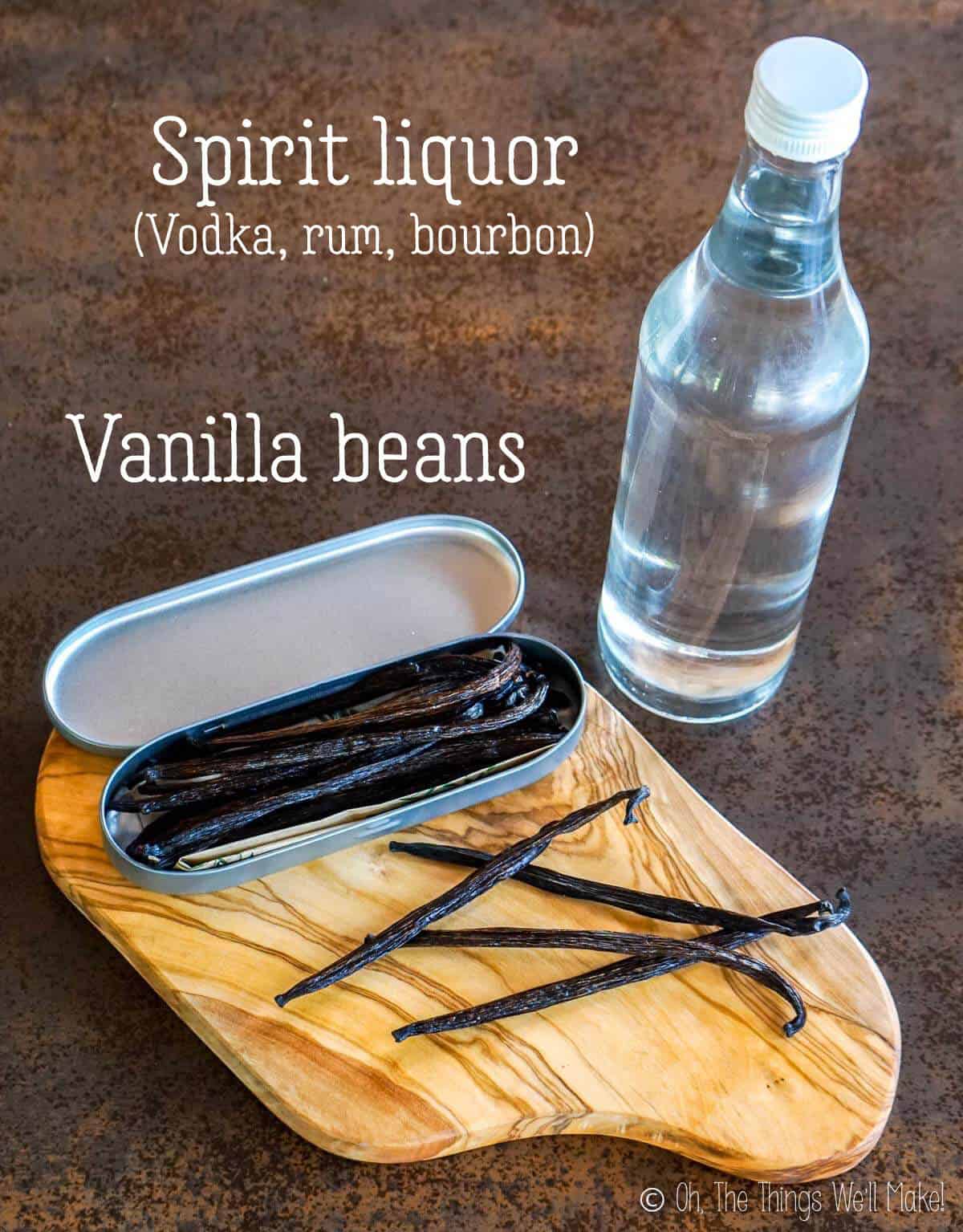
Alcohol
You can also customize your vanilla extract by choosing different alcohol bases for your vanilla infusion.
At first, I always made my vanilla extract with vodka, which seems to be the most popular choice.
With time, I saw recipes for bourbon vanilla extract made with bourbon whisky.
Commercial “bourbon vanilla extract” isn’t really normally made made with bourbon whisky, though. Instead, it’s named after the variety of vanilla used (bourbon vanilla). Perhaps, the name got people to try using bourbon in their extracts. Hearing people rave about the flavor, I had to try it too! I have to say that I understand why so many people love it!
Rum is another good choice. It supposedly provides a smoother vanilla extract than vodka. I just started my latest batch with rum, so I’ll know better soon.
Alcohol-free vanilla extract
For those avoiding alcohol either because of your local government regulations or any other reason, you can make a different type of vanilla extract using glycerin. Glycerin extracts are called glycerites.
Glycerin takes much longer to extract the vanilla flavor than alcohol and also imparts a sweetness to the extract which you may or may not like. If you’re interested, read how to make an alcohol-free vanilla extract.
Procedure
Making the extract couldn’t be simpler. The hardest part is waiting for it to be done.
To begin, slice the vanilla beans lengthwise. This exposes the small seeds within them, making it much easier to extract the full flavor of the vanilla beans.
Once you’ve sliced the vanilla beans in half, place them in a bottle and pour the alcohol over them, covering the beans. Cap the bottles and store them in a cool, preferably dark place.
Over the course of the next weeks, shake or invert the bottle several times every once in a while. This helps disperse the vanilla flavor and color throughout the alcohol.
After about a month, you can begin to use the vanilla extract, but it will take a bit longer to reach its full potency.
Some people are very adamant about not using the extract before a full year has passed, or at least not calling it “vanilla extract” until then. Keeping that in mind, you may not want to gift your extract until you’ve had it going for at least several months and explain that the beans will continue to infuse their color and flavor with time so it’s best to leave them in the alcohol.
Incidentally, I now have a batch from several years ago and one that is just over a month old. I’ve tasted both alone and mixed in homemade milk kefir, and can’t say that I could tell much of a difference either way. I’d still suggest ideally leaving the vanilla beans for as long as possible before using.
To get the most out of your vanilla beans, top off the bottle with more alcohol as you use the extract. (You can continue to do so until you notice that the extract is getting too weak.) If you do notice that the extract is becoming weak, you can also add a fresh vanilla bean or two, as needed.
Labels
Homemade vanilla extract is perfect for gift giving. Whether or not you’re giving it away, labels can make for a more attractive bottle.
Feel free to print out and use mine, if you like!
To use them, right click on the picture below and save it to your computer (Save image as…). I printed them out on a 4×6 inch (10x15cm) photo paper sheet to get the size of the labels in my photos. I then cut them out and used a glue stick to attach the label to the bottle.
If you have sticker paper, you can use that instead. (I suggest using waterproof photo paper and/or sticker paper to ensure a long lasting label.)
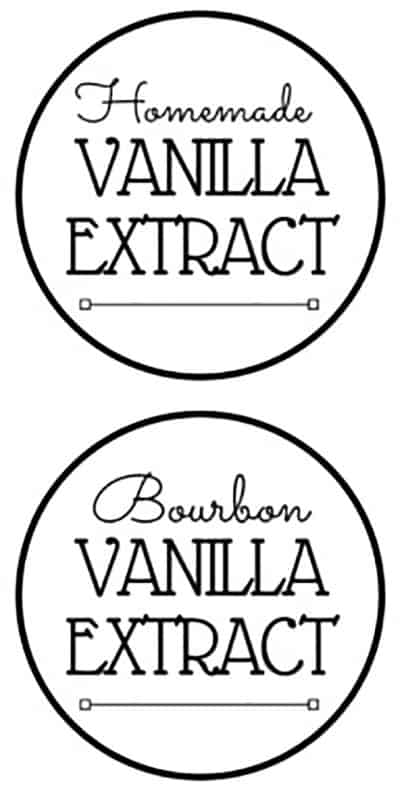
Video

Homemade Pure Vanilla Extract
Ingredients
- 750 ml alcohol (Vodka,bourbon, rum) 35% or higher
- 15 vanilla beans (75g, more or less)
Instructions
- Cut the vanilla beans lengthwise to expose the inner seeds. Place them into a glass bottle or jar.
- Add the alcohol to the bottle, fully covering the beans, and shake the bottle to help disperse the vanilla throughout the alcohol.
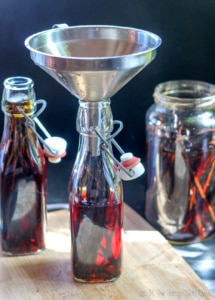
- Store the bottles out of the sunlight for several weeks/months. Shake the contents occasionally. The vanilla extract will progressively darken and take on a stronger vanilla flavor. It will be "ready" for giving as gifts in about a month.
- As you use the extract, you can top it off with a little more alcohol. If you notice that the flavor is weaking, you can add a fresh vanilla bean or two.
Notes
This post was originally published on November 13, 2014. It was rewritten, adding new photos and video in May 2021.
 Español
Español
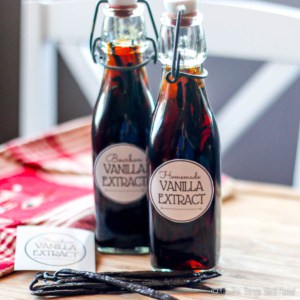
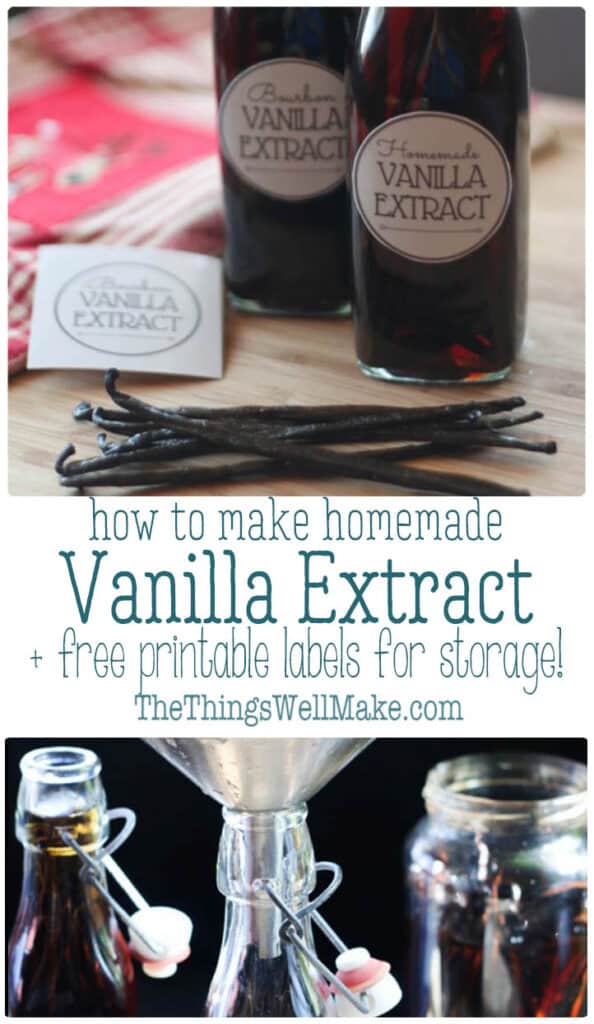
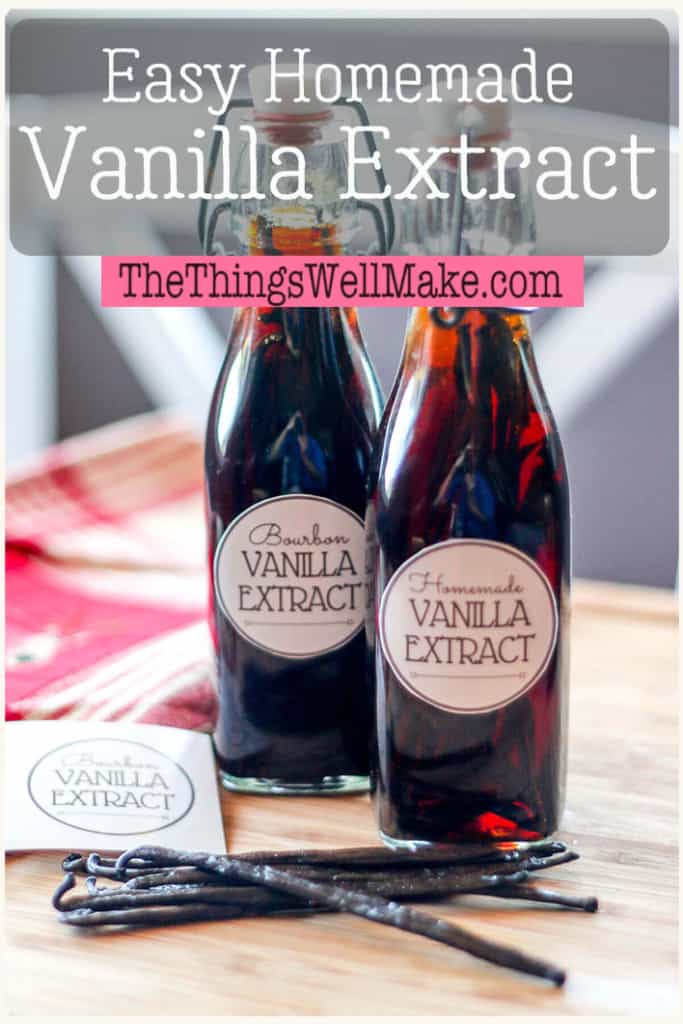
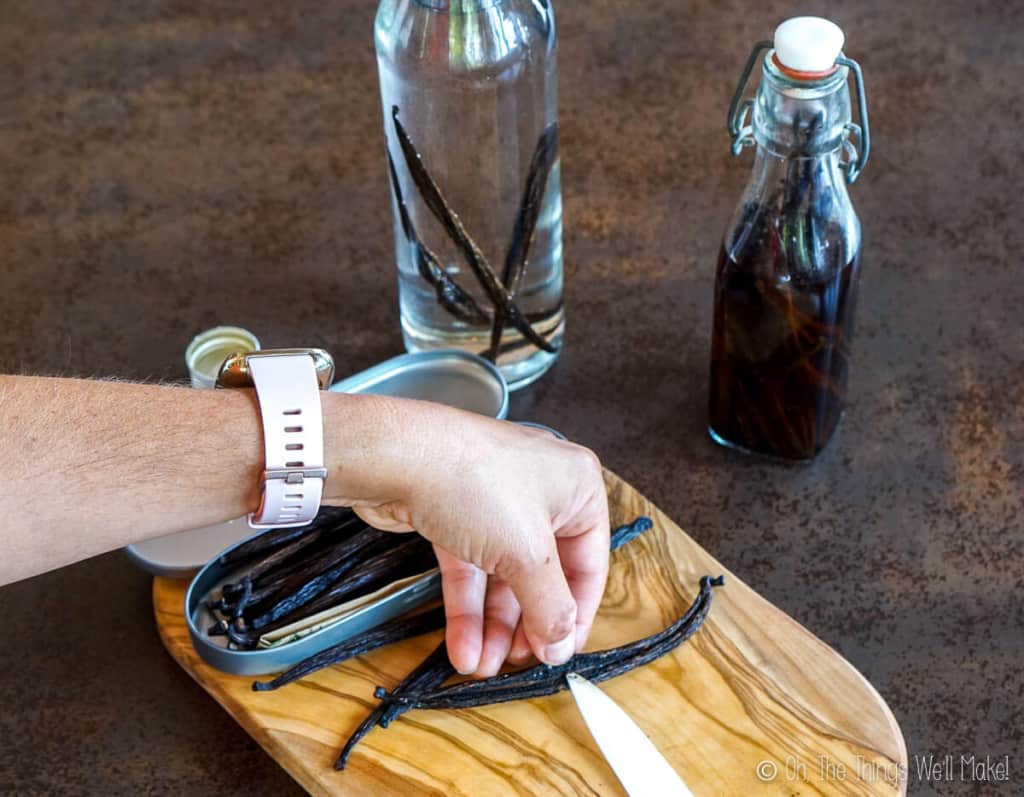
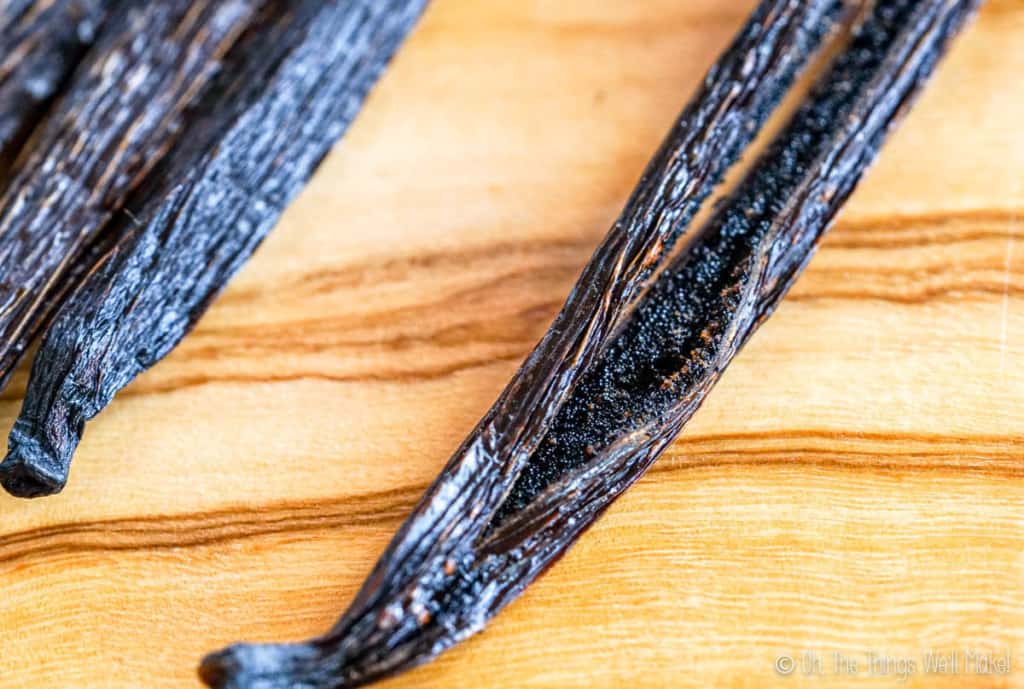
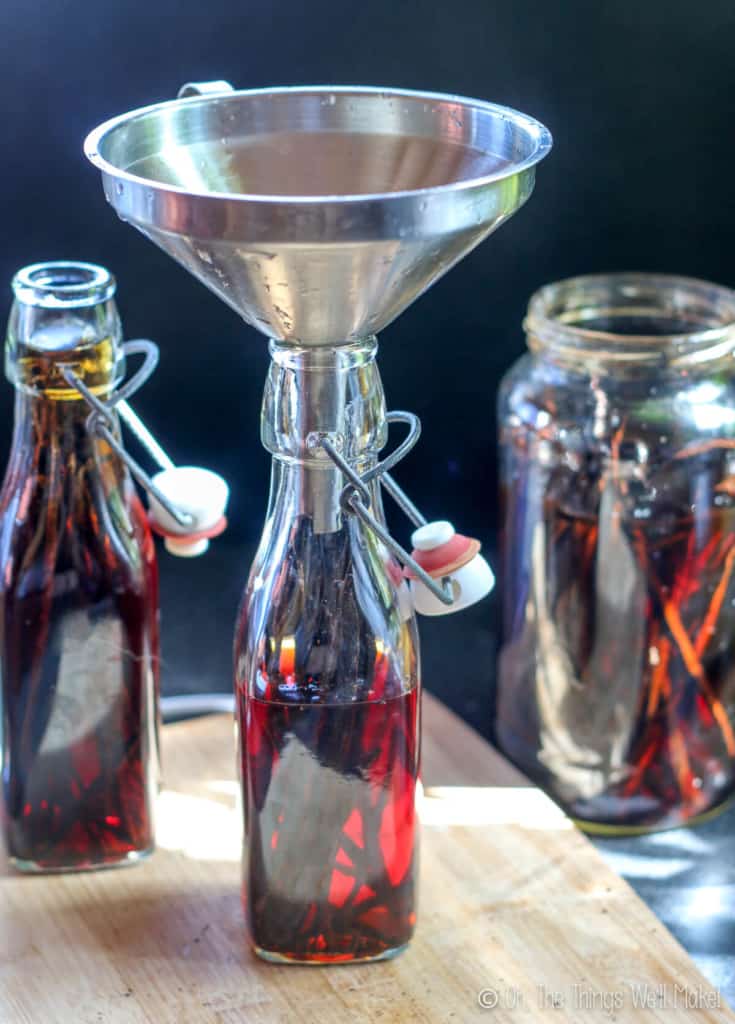
 Alcohol-Free Vanilla Extract
Alcohol-Free Vanilla Extract
superionos
Hello!
After another similar comment, I have actually been working on a post about it.
It’s quite easy to do utilizing vegetable glycerine and a little water, very much like the one you purchase. You use a mixture of glycerine and water instead of the alcohol that I have demonstrated here. I’ve played around with ratios a bit, but it doesn’t seem to make much of a difference. So far, I like about 75% glycerin and 25% water.
The vanilla is preserved by the glycerine, which is actually a little bit sweet on its own, so the “extract” that results is slightly sweet.
I hope that is of use!
Maria
Hi thanks for this recipe it’s really good, but I have a Question, once I have emptied the vanilla extract into small gift bottles, do I throw away the beans or can I still put some more vodka. Thanks Maria
Tracy Ariza, DDS
Hi Maria,
I normally add more vodka. Especially with the price of vanilla beans these days. I like to get as much out of them as is possible!
After a certain point, you won’t get much flavor out of them, but they do tend to work for several batches. (Keep in mind that the first batch will be the strongest, and subsequent batches will likely be a bit lighter. In most recipes, though, it probably won’t make that much of a difference.)
You can also add a new, fresh bean to the others if you feel the batch needs it. 😉
Karen
Emily, thank you for the recipe. I, too, am living in Spain and have had a hard time finding vanilla extract. Do you have to sterilize the bottles before you use them? Thanks!
Tracy Ariza
Hi Karen,
While it’s always a good idea to sterilize bottles before using them, it’s not really 100% necessary. You’re using a high concentration of alcohol, so you should be OK as long as you make sure they are clean and you can take other precautions to help ensure your safety.
I usually just make sure the bottles are clean and then run them through the dishwasher whose heat basically kills anything undesirable. You can also run really hot water in them.
Lately, even the vanilla beans are quite expensive. There were problems with vanilla production a few years back, and I’ve heard the prices should be dropping again soon! I hope so because I’d love to make more soon. 😉
Sandra L Irick
Hi Tracy,
Just recently moved to Valencia and am searching for a vanilla bean source. Any suggestions for that? Thank you
Sandra Irick
Tracy Ariza
Hi Sandra,
I ordered online, but it was several years ago before the prices of vanilla beans skyrocketed!
I can’t remember where I bought them from. Luckily, I bought a lot (probably to save on shipping) and made several large bottles that I’m still using. I have been wanting to buy more soon too, though. I’ve been hearing that in the next year or so, that the vanilla crop may start catching back up to the demand again and that prices may start coming down again! (Fingers crossed)
Sandra L Irick
Hi Tracy
I was able to find vanilla beans at the Mercado Central, although they are expensive. We have a batch going now. Now, the next issue, where do I find bottles? Have looked around Amazon and in some local shops. Suggestions?
Thank you
Sandra I
Tracy Ariza
Hi Sandra,
I’ve heard that this year the vanilla production is starting to get better again. (The prices have soared over the last couple of years as demand has gone up and the fact that there was a problem with the crops. I guess it takes several years to get the plants where they need to form the pods.)
Anyway, here’s to hoping that the prices go back down soon!
I’ve actually bought in local shops mostly, but I love the larger bottles from IKEA. They may have smaller ones too. Their price/quality is great for the bottles. They’re my favorite for making kombucha and building up the gas. I have more expensive ones that don’t seem to seal as well.
Randy Cornelius
Thank you for your post…. I will be trying your non-alcohol version! Is there a big difference in flavor without the alcohol? Thanks for you time…. Have a blessed day!
Tracy Ariza
Hi Randy,
I’ve been meaning to write up a post about that. 🙂
I have a batch in glycerin that has been going for months. The flavor itself is almost identical- well, the vanilla part, of course. The difference is that this version isn’t sweet at all and tastes like alcohol, and the other version is sweeter and maybe not quite as strong. Overall in a recipe I doubt you’d notice much of a difference. You could add a little more of the glycerin version, and maybe cut down the sugar in the recipe by the tiniest bit. (That said, you probably wouldn’t notice the difference either way in a normal recipe, so it’s probably not necessary to make any changes.)
Equagold
I am interested to check whether you could make or give a site that would make vanilla without liquor as a few people are sensitive to it yet at the same time need to make it. The one I purchase is made with glycerice, water, sugar and vanilla extractive. Most likely from some beaver… .
Tracy Ariza
Hello!
I’ve actually been working on a post about it after receiving another similar comment.
It’s actually quite simple to do using vegetable glycerine and a little water, just like the one you buy. You follow the same process that I’ve shown here with the alcohol, but instead use a mixture of glycerine and water. I’ve been experimenting a bit with ratios, but it doesn’t seem to make a huge difference. I like around 75% glycerine with 25% water so far.
The glycerine works as a preservative for the vanilla, and it’s actually a little bit sweet on its own, so the resulting “extract” is slightly sweet.
I hope that helps!
Audrey Darling
I am curious to see if you could make or give a website that would make vanilla without alcohol as some people are allergic to it but still want to make it. The one I buy is made with glycerice, water, sugar and vanilla extractive. Probably from some beaver….
Tracy Ariza
Hi Audrey,
That’s a very good idea, and something I hadn’t really considered. Most people here directly use the seeds of the vanilla pods themselves, or you can also infuse them into sugar to make a vanilla sugar that can be used in sweet recipes. The alcohol is really just to preserve and make something quick and easy to use. I’ve made vanilla sugar several times before and it works very well for adding some vanilla flavor without adding alcohol. (I’d be happy to do a post on it if it interests you.)
I used alcohol in my natural food colorings for the very same reason- to make sure bacteria doesn’t grow and they can be shelf stable for a long time.
I can look into the idea of using glycerine, though. I have a lot of it as I use it in soap making. I’m just not sure about the preserving qualities, if any, that it has. You have definitely piqued my interest, and I’ll try to investigate a little and see what I can come up with. 🙂
If it works out well, it would be a great starting point for elaborating natural food coloring without alcohol too.
For now, I either have to use powdered or the alcohol extract version.
Tracy Ariza
Well, after a bit of research, it turns out that vegetable glycerin works wonderfully well for preserving fresh flavors and for making “glycerites,” which is basically the non-alcoholic version of an extract. So, as we speak, I am now making a test batch of non-alcoholic vanilla extract using glycerine. It is already taking up the color and flavor of vanilla, so it looks very promising. 🙂
Annette Saulnier
Where do you get those cute bottles?
Tracy Ariza
Hi Annette,
I’m actually very lucky in that I can find these bottles pretty inexpensively in the Spanish version of the dollar store here in my town. I’m not lucky enough to get them for a dollar, but they do only cost me a couple of Euros, and I think that’s a pretty good deal. I looked the bottles up on Amazon for someone else who was looking for them, but they were a bit more expensive there.
These were the bottle I found through Amazon (affiliate link) : http://amzn.to/1ENleVe
With as much as I’d love for you to buy something through my link, I’d rather be honest with you and say that I bought mine locally for cheaper. It is an option, though, if you really love them and can’t find them anywhere else.
I looked for cheaper alternatives through Amazon, and couldn’t find any, but they did show other Amazon shops that have them listed as cheaper, but with a higher S&H. Perhaps if you were going to buy several of them, it works out to be more inexpensive that way? I’m not sure.
Emily @ Recipes to Nourish
Love this! I really need to make my own. Beautiful photos. Pinned it.